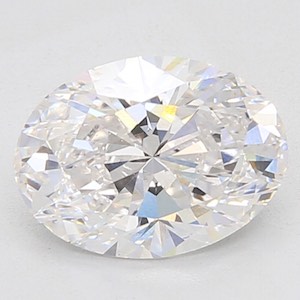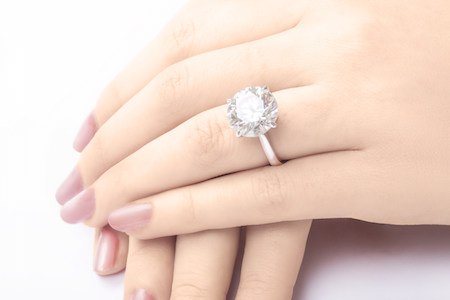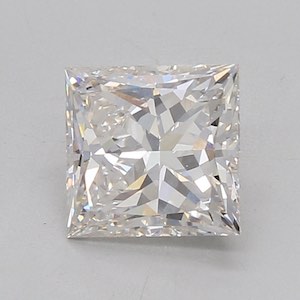
Forget the FTC or GIA. The new created-diamond battle may be over intellectual property.
In an interview this week, executives at WD Lab Grown Diamonds said they believe that certain competitors are infringing on the company’s licensed patents for growing diamonds using chemical vapor deposition (CVD)—and they might take some retailers to court over it.
Since 2011, WD has licensed the diamond-growing technology developed by the Carnegie Institution of Washington, which has an ownership stake in the company.
“What Carnegie did is they established the conditions that you could [grow diamonds] to a reasonable size,” says WD president and founder Clive Hill. “That is patented. We [believe] that you cannot grow CVD outside those conditions.”’
Carnegie’s portfolio of patents also involve post-growth treatment of CVDs using annealing.
While WD has sent warning letters in the past, Hill says it is now taking its efforts to a new, “more significant” level.
“We have sat down and assessed possible costs,” says Hill. “If we have to end up in court, we will end up there.… We have spent a lot of money on this. We are working with [law firm] Perkins Coie. Within a very short period of time we will start some action with some retailers.”
Among the companies it has in its sights: big retailers, manufacturers of growing equipment, and a few smaller players.
“Hopefully we can pick one or two, and people will cooperate with us a bit better,” he says. “We want to work with people. That is our modus operandi. But we want it to be fair. I don’t think that’s unreasonable. We think that retailers, particularly the significant retailers, will want to make sure that happens.”
The company is now able to pursue this avenue because of the capital infusion it received from Detroit-based private equity firm Huron Capital Partners late last year.
Huron senior partner Michael Beauregard says that WD isn’t trying to limit supply in the market and that it will consider licensing or other arrangements.
“What we would like to do is supply those retailers that we haven’t been supplying,” he says. “The goal is not to create hostilities. The goal is to be able to sell this company’s technology to more customers. There are several retailers that are good and viable customer prospects for this company that have chosen some or part of their product flow to come from parties that have been infringing, in our opinion, on one or more of the patents. They are going to be made aware of that.”
The company is initially targeting retailers, rather than the companies that produce the diamonds, because “we can’t necessarily trace diamonds back to the source,” says Michael Zukas, vice president of private equity for Huron and a WD director. “But we can buy from a retailer and test those diamonds from the retailers and [allege], ‘this is a violation.’
“We have invested in our partnership with Carnegie and the technology that we are licensing,” he says, “and we want to make sure that the playing field is fair and we want to make sure the investment is protected.”
While WD stayed mum on possible targets, JCK reached out to other CVD diamond producers for comment. Diamond Foundry chief executive officer Martin Roscheisen responded via email: “We have invested years of research and development to take the technology for growing high-quality diamond to a distinctly new level. Our proprietary intellectual property stands on its own.” Singapore-based IIA Technologies, which is currently in a patent fight with Element Six, did not return a request for comment. The agreed purchaser of Scio Diamond has suggested that other companies are infringing on its patents.

Aside from this possible patent fight, WD has a lot on its plate. Since the investment from Huron, its production has doubled, though it’s not providing numbers.
“We are not going to reveal production volumes,” says Beauregard. “We think that production targets and wish lists are different from your ability to service consumers.”
Ironically, for a company that claims the patent to post-growth treatment, all of its production is “as grown,” with no added treatments. That’s because a lot of treated stones get a grayish tinge, says chief technology officer Yarden Tsach.
The company specializes in diamonds over 1 carat, I color and above, and over SI clarity, up to VS. And it sells primarily to retailers, as well as retail middlemen, but avoids selling direct to consumers.
“My background is, I am a retailer,” says Hill, the former CEO of U.K. chain Fraser Hart. “I used to hate it when my customers used to compete with me. I am not going to compete with my customers.”
It also sells polished, rather than rough.
“I’d much rather have a customer base that deals with us and has a relationship with us and is stable, so they are buying from us next month and then the next month,” he says, “then supply into some kind of highly commoditized market that is volatile and the demand for my goods was less regular. I do want to be downstream. I do want to be touching the customers. I don’t want to be reduced to a bulk chemical producer.”
Huron says it became interested in WD because of its intellectual property assets, its ability to track its stones, its ability to customize its production, and the people involved. “Clive and Yarden are a little bit of a different breed than many of the players that they are competing with and that are related to gem production,” says Beauregard.
Unlike other private equity players, Huron says it’s in no rush to cash out.
“Our firm has been involved in equity market for over 20 years,” Beauregard says. “As an established firm, we have no pressures for exits at any time. As this company is able to enhance its intrinsic value, we will keep funding the business and keep enjoying the growth of the underlying company. It is possible that this company will get to the threshold needed to do an IPO, especially if it’s diversified by industries. It has that growth profile.”

Other topics covered in our conversation, which took place at WD’s headquarters in an office park in Maryland:
– Hill is staying out of the debates on whether lab-diamonds are more eco-friendly than mined.
He feels that lab-grown companies initially stressed the eco aspect because of a certain “embarrassment” about the product.
“Then people realized actually consumers are intelligent, you don’t have to tell them a story. It’s very obvious why they should buy the lab-grown stones. You get more for your dollar.”
For that reason, he’s not interested in having his operations audited by outside parties or providing info about kilowatt-hours. “We are a relatively discreet organization,” says Hill, who formerly worked in wind power. “I don’t want people running about here doing energy audits.
“Ultimately renewable energy is a national decision,” he continues. “How much do you want to encourage it? How easy do you want to make getting permits? The mix will become more renewable at some point. But when it does is above my pay grade. You can’t hypothecate energy. It’s nonsense.”
– As far as the prices of lab-grown diamonds: Hill admits that they have decreased but says that people are looking at this the wrong way.
“I always feel that question is a little bit back to front. What is really happening, as I see it, is consumers are getting more for their dollar. They look at us, and they say, ‘This is a technology business, I expect to get a little bit more than I did last year.’ ”
He says that many of the companies that worry about the stones losing value are the same companies that will “sell something and 20 minutes later, if [the buyer] comes back, they will offer them 20 cents on the dollar.”

– As for the future of the sector, Hill feels created-diamond sales are now constrained only by supply. He thinks demand will increase, and by next year lab-grown diamonds will be firmly mainstream.
“Lab-grown will take market share from mined stones, that’s inevitable, that is not preventable. I have been a retailer. I understand how frightening this change must be to a lot of the traditional retailers. Someone who has been in a relatively slow-moving business their whole life is suddenly faced with this thing changing, it has got to be scary. They have got to be worried. But they have to do what consumers want. The reality is, this genie is not going back in the bottle.”
(Images courtesy of WD Lab Grown Diamonds)
Follow JCK on Twitter: @jckmagazine
Follow JCK on Facebook: @jckmagazine